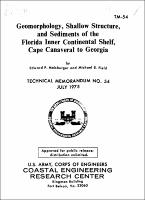Please use this identifier to cite or link to this item:
https://hdl.handle.net/11681/21442Full metadata record
| DC Field | Value | Language |
|---|---|---|
| dc.contributor.author | Meisburger, Edward P. | - |
| dc.contributor.author | Field, Michael E. | - |
| dc.date.accessioned | 2017-02-15T17:41:49Z | - |
| dc.date.available | 2017-02-15T17:41:49Z | - |
| dc.date.issued | 1975-07 | - |
| dc.identifier.uri | http://hdl.handle.net/11681/21442 | - |
| dc.description | Technical Memorandum | en_US |
| dc.description.abstract | Abstract: The inner Continental Shelf off eastern Florida between Cape Canaveral and Georgia was surveyed to obtain information on bottom morphology and sediments, subbottom structure, and sand deposits (borrow sites) suitable for restoration and nourishment of nearby beaches. Primary survey data consist of 1,153 statute miles of high-resolution seismic reflection surveys and 197 sediment cores. The major structural trend in the study area shallow subbottom is a broad coastal plain high consisting of truncated strata judged to be of Eocene and Miocene ages. Overlying strata not affected by the high are late Miocene to Holocene in age and are characterized by a predominant eastward dip, common occurrence of internal bedding features, and filled erosional channels. The Pleistocene and Holocene sediments disconformably overlie late Tertiary sediments which crop out in many places north of St. Augustine, Florida. The dominant lithelogy of both surficial and shallow subsurface strata is quartz sand. Detrital accessory silicate minerals, carbonates, and phosphorite comprise the remaining 5 to 10 percent of the sediments. Surface exposures and near-surface occurrences of Tertiary unconsolidated quartzose sands are recognized by diagnostic microfauna or dolomite silt matrix. Quaternary sediments are unusually thin and discontinuous. The paucity of recognizable Pleistocene fluvial deposits in this region and the thin nature of the Holocene sand blanket suggests that shelf sands were derived in part from transgressive erosion and that Georgia streams supplied little material to the inner shelf. Sand suitable for beach restoration and maintenance on the adjacent north Florida coast occurs abundantly in places on the inner shelf. Ten potential borrow sites and an additional 21 possible sites have been delineated, each comprising a sand reserve ranging in volume from 5 to 178 million cubic yards, all within 13 nautical miles of the coast. Underlying quartzose Tertiary deposits contain an estimated 100 billion cubic yards of sand. Filled erosional channels in shallow subbottom strata, especially north of Jacksonville, and the occasional occurrence of sinkholes, complicate generalization of foundation conditions. Clays and cohesive sandy silts occur throughout the area in various stratigraphic associations. The character and strength properties of these fine-grained deposits are variable; however, soft watery clays, usually interbedded with fine sand, are most common in the area from Jacksonville to Georgia. | en_US |
| dc.publisher | Coastal Engineering Research Center (U.S.) | en_US |
| dc.publisher | Engineer Research and Development Center (U.S.) | en_US |
| dc.relation.ispartofseries | Technical memorandum;no. 54 | - |
| dc.rights | Approved for public release; distribution is unlimited. | - |
| dc.source | This Digital Resource was created from scans of the Print Resource. | - |
| dc.subject | Continental shelf--Florida | en_US |
| dc.subject | Geomorphology--Florida | en_US |
| dc.subject | Marine sediments--Florida | en_US |
| dc.title | Geomorphology, shallow structure, and sediments of the Florida inner continental shelf, Cape Canaveral to Georgia | en_US |
| dc.type | Report | - |
| Appears in Collections: | Technical Memorandum | |
Files in This Item:
| File | Description | Size | Format | |
|---|---|---|---|---|
| CERC Technical Memorandum No 54.pdf | 13.64 MB | Adobe PDF |  View/Open |